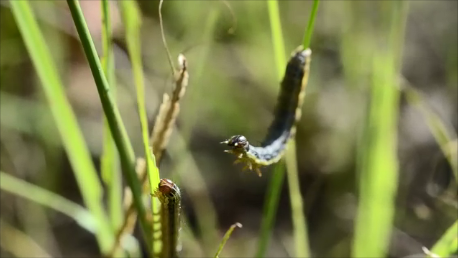Farm & Ranch
[AgriLife Today] Fall armyworms are on the march

By: Adam Russell
- Writer: Adam Russell, 903-834-6191, [email protected]
- Contact: Vanessa Corriher-Olson, 903-834-6191, [email protected]
OVERTON – Fall armyworms are on the march in parts of Texas.
Texas A&M AgriLife Extension Service agents in a few of the agency’s districts have reported increased armyworm activity in hayfields and pastures over the past few weeks. Dr. Vanessa Corriher-Olson, AgriLife Extension forage specialist in Overton, said producers should expect an increase in armyworm numbers following recent rains and cooler temperatures in areas of the state.
“I was getting calls about them before the rain,” she said. “They like cooler temperatures and wet conditions in the spring and fall, so we could see a swell in their numbers.”
Armyworm moths can lay up to 2,000 eggs that hatch in two to three days, according to a 2015 report by AgriLife Extension entomologist Dr. Allen Knutson. There are four to five generations per year.
Corriher-Olson said armyworm caterpillars are picky eaters that prefer high–quality, fertilized forage typically found on fields maintained for hay production. They are a common pest of Bermudagrass, sorghum, corn, wheat, rye grass and many other crops in north and central Texas.
Producers should scout each morning for armyworms, she said. Armyworms are night feeders that try to avoid daytime temperatures.
Armyworms are green, brown or black in color and can be identified by the white inverted Y on their head. They can grow up to 1 inch in length when mature.
https://www.youtube.com/watch?v=hZlhX9mSkRU
The pest got its name because they appear to march across hay fields, consuming the grass in their path.
The threshold for insecticide spray treating a pasture is three or more armyworms per square foot, Corriher-Olson said. Armyworms in those numbers should be treated immediately. Armyworms in the last two or three days of their larvae stage consume 85 percent of their diet.
Corriher-Olson recommends insecticides labeled for armyworm control in pastures and hayfields. She said applicators should always follow all label instructions on pesticide use and restrictions.
“You don’t need to wait a day if their numbers are at threshold,” she said. “They are going to do a lot of damage quickly. If you find them in the morning, spray that day.”
More information about armyworms can be found in Knutson’s report The Fall Armyworm – Pest of Pastures and Hay at: http://foragefax.tamu.edu/files/2015/08/Armyworm-Fact-Sheet-2015.pdf.
-30-
Find more stories, photos, videos and audio at http://today.agrilife.org
Farm & Ranch
Hazards of Backyard Poultry

By Barry Whitworth, DVM
Having backyard poultry is a popular agriculture enterprise. According to the United States Department of Agriculture, 0.8 percent of all households in the United States have chickens. People keep chickens for a variety of reasons with table eggs being one of the more common reasons.
Unfortunately, some of these poultry producers are not aware of the hazards that come with keeping poultry because many times they carry pathogens but appear healthy.
Chickens are carriers of several zoonotic diseases. These are diseases that can be passed from animals to humans. According to a recent survey in Pennsylvania, a majority of backyard poultry producers were aware of the dangers of avian influenza. However, this study also revealed that far fewer producers were aware of the risk of possible exposure to Salmonella and Campylobacter.
The lack of knowledge about the hazards of raising poultry likely contributes to the continued issues of Salmonella outbreaks associated with backyard poultry. In 2023, the Centers for Disease Control and Prevention reported 1,072 illnesses of Salmonella linked to backyard poultry, and 272 of those patients required hospitalization. Oklahoma reported 43 individuals with the disease.
To read more, pick up a copy of the April issue of NTFR magazine. To subscribe by mail, call 940-872-5922.
Farm & Ranch
Ag Elsewhere: Wyoming

By Tressa Lawrence
Babies are tucked away in every nook and cranny. Many ranchers across Wyoming have baby animals popping up all over this time of year.
Farm & Ranch
Ag Elsewhere: Montana

By Lindsey Monk
Another load of grain in to keep feeding the calves until the green grass can really start popping.
-

 Country Lifestyles1 year ago
Country Lifestyles1 year agoScott & Stacey Schumacher: A Growth Mindset
-

 Equine7 months ago
Equine7 months agoThe Will to Win
-

 Country Lifestyles7 years ago
Country Lifestyles7 years agoStyle Your Profile – What your style cowboy hat says about you and new trends in 2017
-

 Country Lifestyles4 years ago
Country Lifestyles4 years agoAmber Crawford, Breakaway Roper
-

 HOME7 years ago
HOME7 years agoGrazing North Texas – Wilman Lovegrass
-

 Country Lifestyles7 years ago
Country Lifestyles7 years agoDecember 2016 Profile, Rusty Riddle – The Riddle Way
-

 Country Lifestyles8 years ago
Country Lifestyles8 years agoJune 2016 Profile – The man behind the mic: Bob Tallman
-

 Outdoor9 years ago
Outdoor9 years agoButtercup or Primrose?






